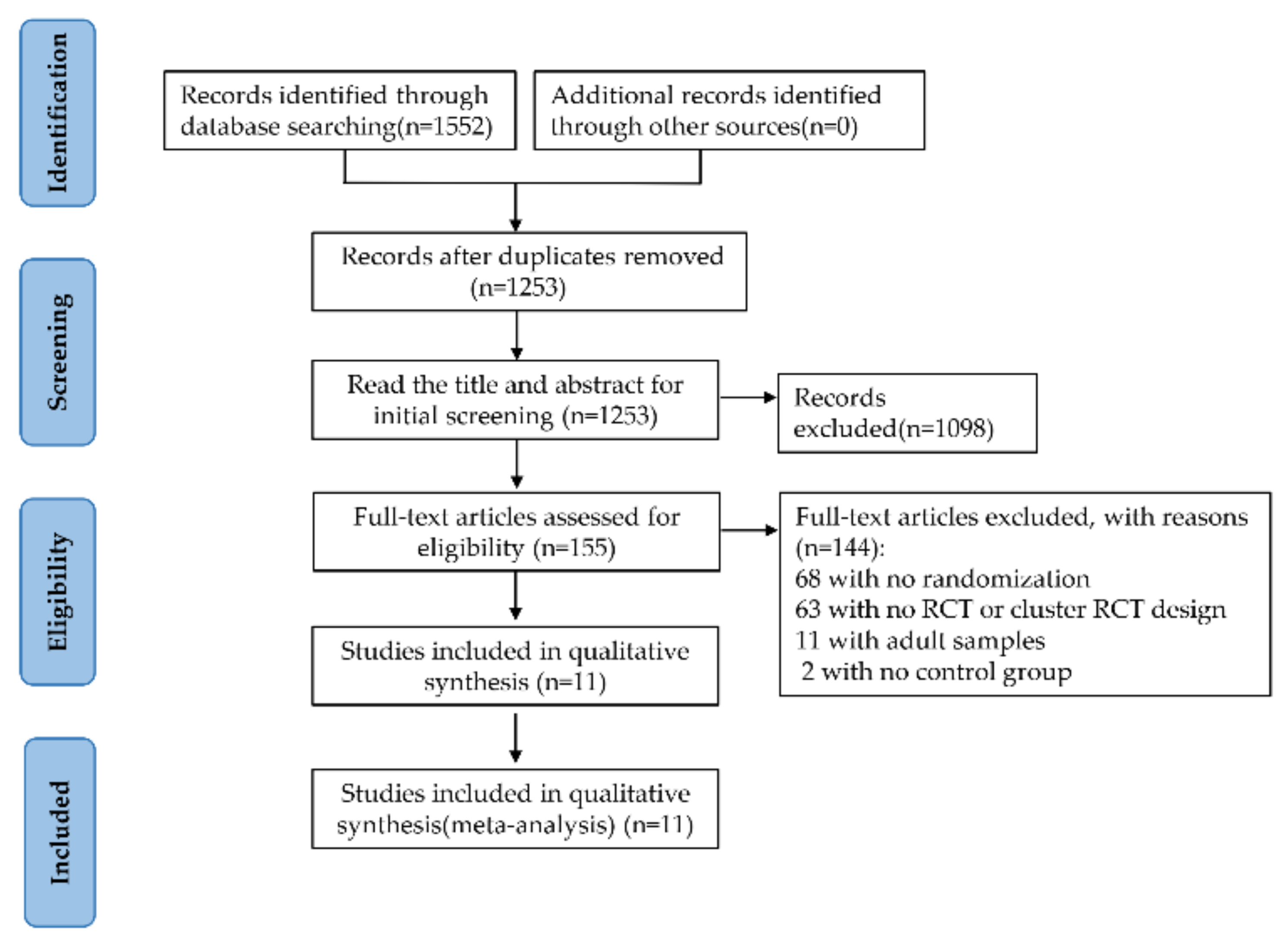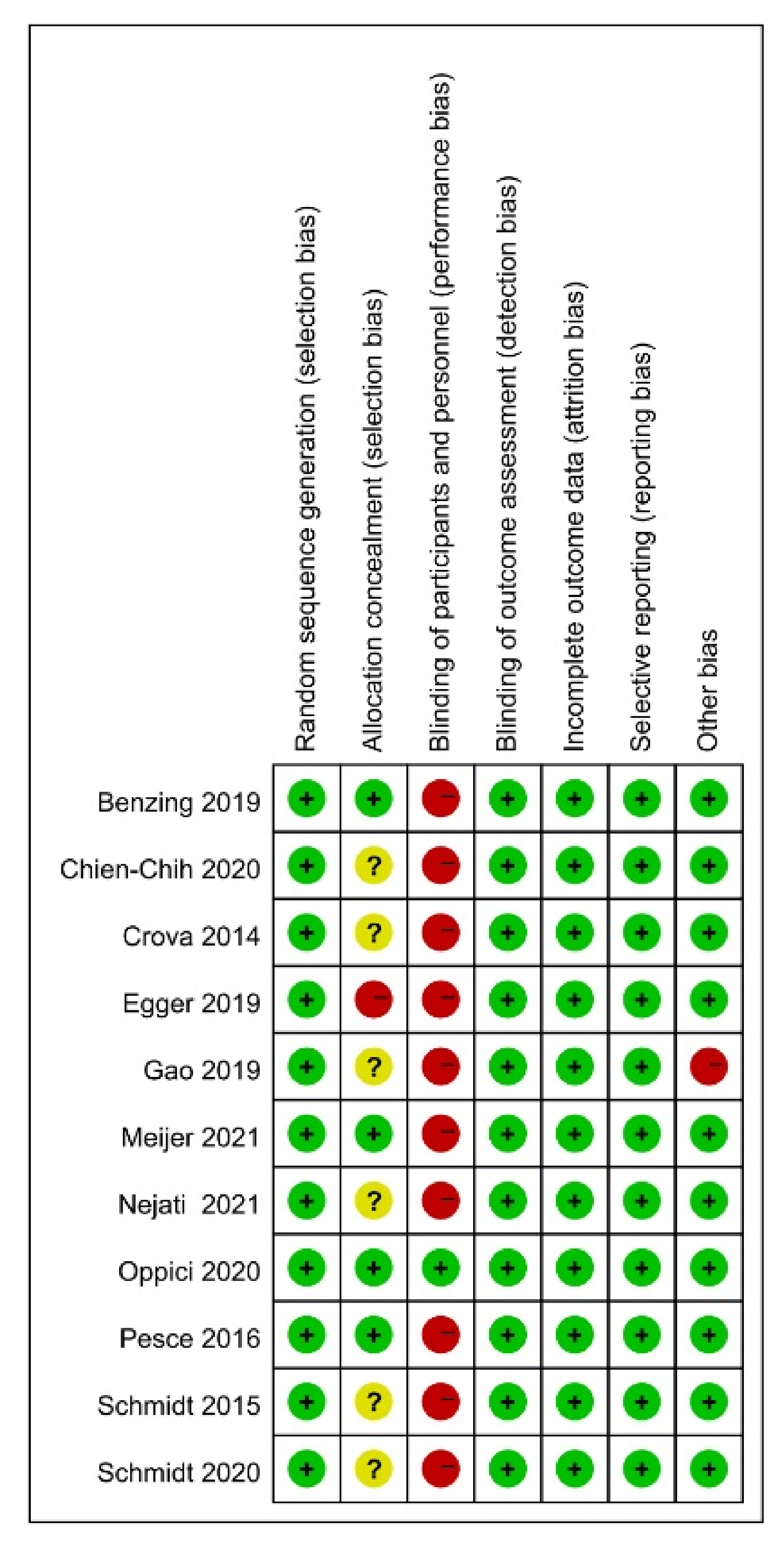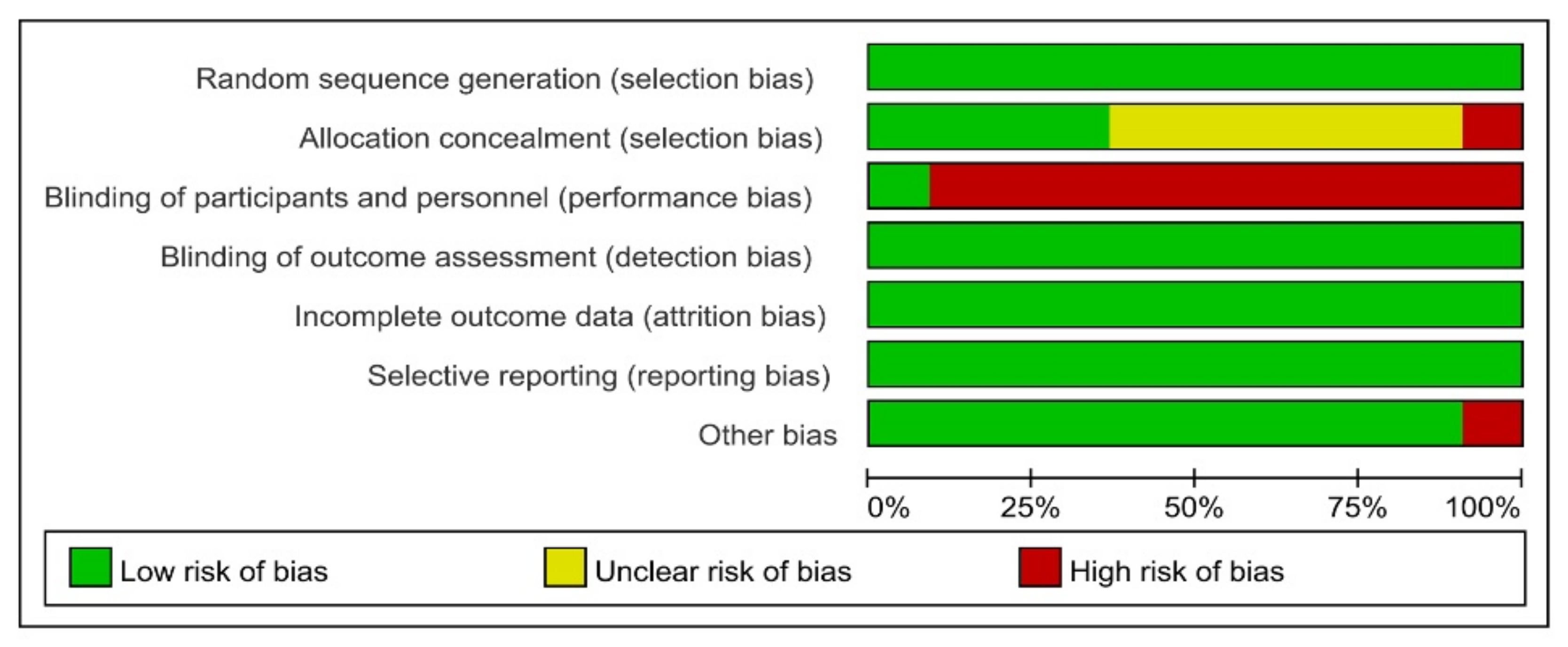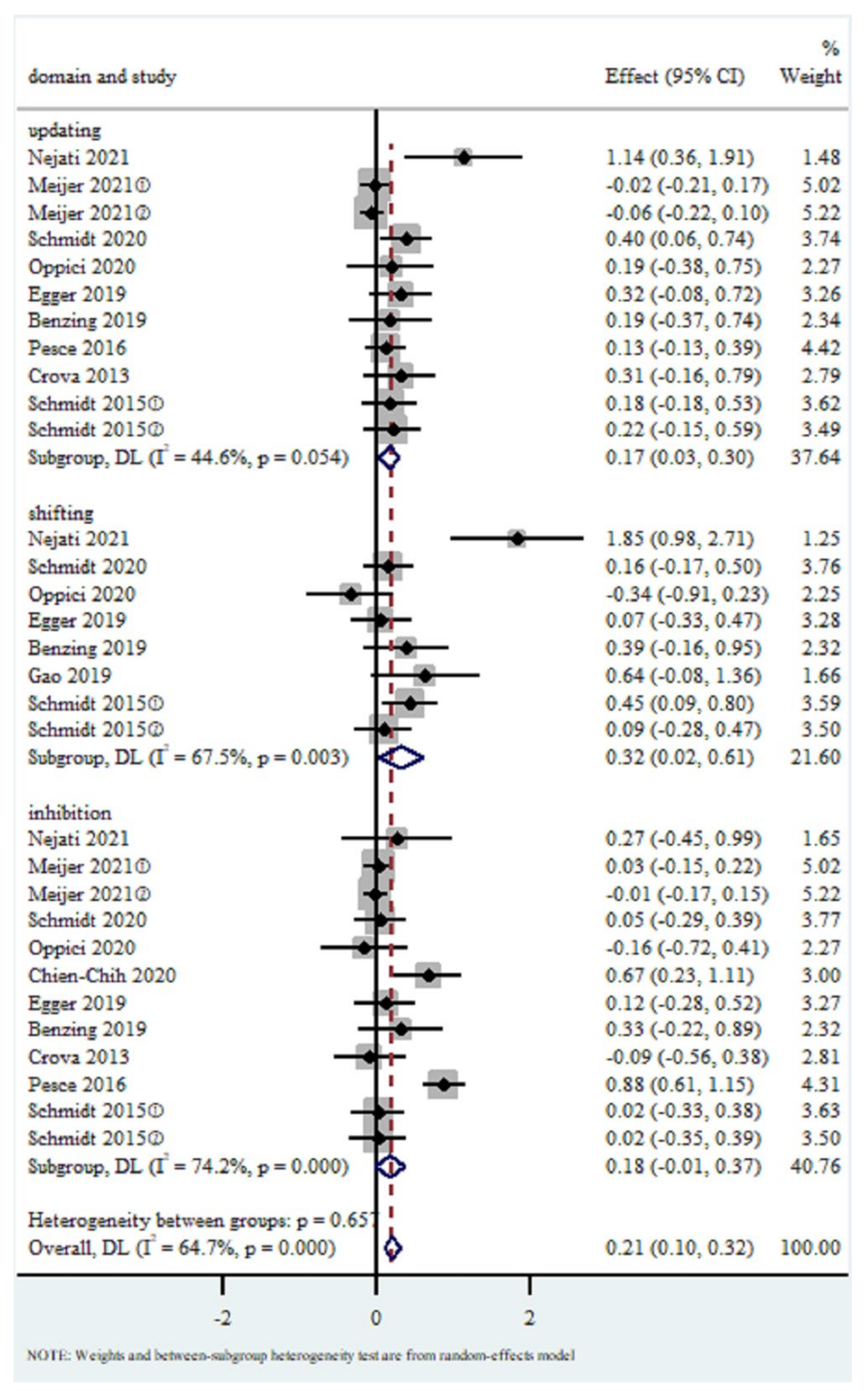Play Smart, Be Smart? Effect of Cognitively Engaging Physical Activity Interventions on Executive Function among Children 4~12 Years Old: A Systematic Review and Meta-Analysis
Abstract
:1. Introduction
2. Materials and Methods
2.1. Search Strategy
2.2. Inclusion and Exclusion Criteria
2.3. Collection of Studies
2.4. Data Extraction
2.5. Assessment of Study Quality
2.6. Statistical Analysis
3. Results
| Study | Design | Participants Characteristic | EF Variables | Instrument | Intervention/Duration | |||
|---|---|---|---|---|---|---|---|---|
| Mean Age (Years) | N | Male/Female | Experimental Group the Form of Interventions | Control Group the Form of Interventions | ||||
| Nejati et al. [34] | RCT | 9.43 | 26 | 0/100 | Updating Shifting Inhibition | ①②③ | EXCIR sessions 40–50 min/session, 3 times/wk, 5 weeks e.g., Color Jumping To jump on a color cell in a table of colors given the meaning of some presented color words on the screen. | aerobic exercise sessions 40–50 min/session, 3 times/wk, 5 weeks aerobic exercise program without cognitive load, running. |
| Meijer et al. (1) [24] | Cluster RCT | 9.1 | 441 | 230/221 | Updating Inhibition | ④⑤ | cognitively engaging PA 30 min/session, 4 times/wk, 12 weeks team games or exercises that require complex coordination of movements, strategic play, cooperation between children, anticipating the behavior of teammates or opponents, and dealing with changing task demands, such as dodge ball, basketball | aerobic exercise sessions 30 min/session, 4 times/wk, 12 weeks The focus was on highly repetitive and automated exercises, such as circuit training, relay games, playing tag, and individual activities like running or doing squats. |
| Meijer et al. (2) [24] | Cluster RCT | 9.1 | 650 | 232/418 | Updating Inhibition | ④⑤ | cognitively engaging PA 30 min/session, 4 times/wk, 12 weeks | regular PE session 30 min/session, 2 times/wk, 12 weeks Children in the control group followed their regular physical education lessons |
| Schmidt et al. [35] | Cluster RCT | 5.34 | 137 | 64/73 | Updating Inhibition Shifting | ①⑥⑦ | combined physical and cognitive training 15 min/session, 4 times/wk, 12 weeks The games were conceptualized to require gross motor movements, which in turn should increase PA, e.g., One Lizard, two lizards | regular PE session 15 min/session, 4 times/wk, 12 weeks The control condition consisted of an active waiting-list group |
| Oppici et al. [36] | RCT | 8.8 | 50 | 28/32 | Updating Inhibition Shifting | ⑦⑧⑨ | high-cognitive PA 60 min/session, 2 times/wk, 7 weeks The dance lessons took place during the participants’ PE and sport classes | regular PE session 60 min/session, 2 times/wk, 7 weeks |
| Chien et al. [37] | RCT | 12.1 | 84 | 52/32 | Inhibition | ⑩ | combined games and object manipulation skills; 3 times/wk, 8 weeks Movement concepts and skills focused on the ability to move in various situations, respond to speed, direction and force of movements, and control body movements while jumping, throwing, catching, dribbling, kicking, or passing. | regular PE session 3 times/wk, 8 weeks session were designed to focus on sport skill development |
| Egger et al. [21] | Cluster RCT | 7.95 | 96 | 42/54 | Updating Inhibition Shifting | ⑨⑪⑫ | cognitively engaging PA 10 min/time, 2 times/wk, 20 weeks For example, children were standing in a circle and playing the game “Horserace”. | aerobic exercise sessions 10 min/time, 2 times/wk, 20 weeks This condition was designed to promote children’s aerobic fitness. Although it is not possible to exclude cognitive engagement entirely from long-term PA interventions, the attempt was made to choose exercises that had as little cognitive demand as possible. |
| Benzing et al. [38] | RCT | 10.63 | 51 | 42/9 | Updating Shifting Inhibition | ⑬⑭⑮ | “Shape up” game 30 min/session, 3 times/wk, 8 weeks “Beatmaster Training Quest”: It consists of different exercises such as: (A) “Waterfall Jump”: The player stands on the edge of a waterfall and has to jump onto oncoming pieces (footprints) of wood in order not to fall down. While the frequency, size and order of the footprints vary the player has to jump with one or two legs in order to hit the footprints. | Waiting-list control group. |
| Gao et al. [39] | RCT | 4.72 | 32 | 16/16 | Shifting | ⑦ | exergaming intervention, The intervention program requested children participate in home-based educational exergaming using the Leap TV gaming console for at least 30 min/session 5 times/week beyond their usual PA. | regular PE session 30 min/session 5 times/wk, 12 weeks The control condition asked children to maintain regular PA patterns without any exergaming gameplay, with parents advised to not change their children’s regular PA routine during their child(ren)’s time in this condition. |
| Crova et al. [40] | RCT | 9.6 | 70 | 35/33 | Updating Inhibition | ⑯ | The enhanced PE programme 21 weeks with one curricular PE class per week plus two additional hours of skill-based and tennis-specific training. The curricular programme consisted of only one PE class per week and was focused on the development of fundamental motor skills and coordinative abilities, bodily expression and deliberate play | Traditional PE programme, 21 weeks |
| Pesce et al. [41] | cluster RCT | N/A | 460 | 232/228 | Updating Inhibition | ⑯ | cognitively engaging PA employed in this intervention had characteristics of deliberate play and deliberate preparation 1 h/week, 6 months | Traditional PE 1 h/week, 6 months |
| Schmidt et al. (1) [23] | RCT | 11.3 | 126 | 54/72 | Updating Shifting Inhibition | ①⑨ | Combined high PA and cognitive engagement. This intervention consisted of specifically designed team games (football and basketball) tailored to challenge EFs. 45 min/session, 2 times/wk, 6 weeks | Aerobic Exercise. This condition consisted of different group-oriented and playful forms of aerobic exercises, whose main aim was to promote children’s aerobic fitness. 45 min/session, 2 times/wk, 6 weeks |
| Schmidt et al. (2) [23] | RCT | 11.3 | 124 | 54/70 | Updating Shifting Inhibition | ①⑨ | Combined high PA and cognitive engagement. This intervention consisted of specifically designed team games (football and basketball) tailored to challenge EFs. 45 min/session, 2 times/wk, 6 weeks. | combined low PA and cognitive engagement, according to the national curriculum for physical education 45 min/session, 2 times/wk ,6 weeks |
3.1. Study Characteristic
3.2. Methodological Evaluation of the Included Literature
3.3. Heterogeneity Test and Sensitivity Analysis
3.4. Effects of Cognitively Engaging PA on EFs
3.5. Moderator Analysis
4. Discussion
4.1. The Overall Effect of Cognitively Engaging PA on EFs
4.2. Comparisons with Previous Studies
4.3. Analysis of Regulatory Variables between Cognitively Engaging PA and EFs
4.4. Cognitively Engaging PA Changes the Underlying Mechanism of EFs in Children
4.5. Strengths and Limitations
5. Conclusions
Author Contributions
Funding
Institutional Review Board Statement
Informed Consent Statement
Data Availability Statement
Acknowledgments
Conflicts of Interest
References
- Diamond, A. Executive Functions. Annu. Rev. Psychol. 2013, 64, 135–168. [Google Scholar] [CrossRef]
- Miyake, A.; Friedman, N.P.; Emerson, M.J.; Witzki, A.H.; Howerter, A.; Wager, T.D. The Unity and Diversity of Executive Functions and Their Contributions to Complex “Frontal Lobe” Tasks: A Latent Variable Analysis. Cogn. Psychol. 2000, 41, 49–100. [Google Scholar] [CrossRef] [PubMed]
- Miller, E.K.; Lundqvist, M.; Bastos, A.M. Working Memory 2.0. Neuron 2018, 100, 463–475. [Google Scholar] [CrossRef] [PubMed]
- Dajani, D.R.; Uddin, L.Q. Demystifying cognitive flexibility: Implications for clinical and developmental neuroscience. Trends Neurosci. 2015, 38, 571–578. [Google Scholar] [CrossRef] [PubMed]
- Watson, A.; Timperio, A.; Brown, H.; Best, K.; Hesketh, K.D. Effect of classroom-based physical activity interventions on academic and physical activity outcomes: A systematic review and meta-analysis. Int. J. Behav. Nutr. Phys. Act. 2017, 14, 1–24. [Google Scholar] [CrossRef]
- De Bruijn, A.; Hartman, E.; Kostons, D.; Visscher, C.; Bosker, R. Exploring the relations among physical fitness, executive functioning, and low academic achievement. J. Exp. Child Psychol. 2018, 167, 204–221. [Google Scholar] [CrossRef]
- Schoemaker, K.; Bunte, T.; Wiebe, S.A.; Espy, K.A.; Deković, M.; Matthys, W. Executive function deficits in preschool children with ADHD and DBD. J. Child Psychol. Psychiatry 2011, 53, 111–119. [Google Scholar] [CrossRef]
- Zanini, D.S.; Ferreira, L.D.O.E.; Junqueira, K.F.L. Living with Violence and Its Relationship with Executive Function in Childhood and Adolescence: Literature Review. Health-Relat. Qual. Life Meas. Tools Predict. Modif. 2022. [Google Scholar] [CrossRef]
- Best, J.R.; Miller, P.H. A Developmental Perspective on Executive Function. Child. Dev. 2010, 81, 1641–1660. [Google Scholar] [CrossRef]
- Contreras-Osorio, F.; Campos-Jara, C.; Martínez-Salazar, C.; Chirosa-Ríos, L.; Martínez-García, D. Effects of Sport-Based Interventions on Children’s Executive Function: A Systematic Review and Meta-Analysis. Brain Sci. 2021, 11, 755. [Google Scholar] [CrossRef]
- Diamond, A.; Ling, D.S. Conclusions about interventions, programs, and approaches for improving executive functions that appear justified and those that, despite much hype, do not. Dev. Cogn. Neurosci. 2015, 18, 34–48. [Google Scholar] [CrossRef]
- Xue, Y.; Yang, Y.; Huang, T. Effects of chronic exercise interventions on executive function among children and adolescents: A systematic review with meta-analysis. Br. J. Sports Med. 2019, 53, 1397–1404. [Google Scholar] [CrossRef]
- Álvarez-Bueno, C.; Pesce, C.; Cavero-Redondo, I.; Sánchez-López, M.; Martínez-Hortelano, J.A.; Martínez-Vizcaíno, V. The Effect of Physical Activity Interventions on Children’s Cognition and Metacognition: A Systematic Review and Meta-Analysis. J. Am. Acad. Child Adolesc. Psychiatry 2017, 56, 729–738. [Google Scholar] [CrossRef]
- Wassenaar, T.M.; Williamson, W.; Johansen-Berg, H.; Dawes, H.; Roberts, N.; Foster, C.; Sexton, C.E. A critical evaluation of systematic reviews assessing the effect of chronic physical activity on academic achievement, cognition and the brain in children and adolescents: A systematic review. Int. J. Behav. Nutr. Phys. Act. 2020, 17, 1–18. [Google Scholar] [CrossRef]
- Vazou, S.; Pesce, C.; Lakes, K.; Smiley-Oyen, A. More than one road leads to Rome: A narrative review and meta-analysis of physical activity intervention effects on cognition in youth. Int. J. Sport Exerc. Psychol. 2016, 17, 153–178. [Google Scholar] [CrossRef]
- Moreau, D.; Conway, A.R.A. Cognitive enhancement: A comparative review of computerized and athletic training programs. Int. Rev. Sport Exerc. Psychol. 2013, 6, 155–183. [Google Scholar] [CrossRef]
- Tomporowski, P.D.; Pesce, C. Exercise, sports, and performance arts benefit cognition via a common process. Psychol. Bull. 2019, 145, 929–951. [Google Scholar] [CrossRef]
- Best, J.R. Effects of physical activity on children’s executive function: Contributions of experimental research on aerobic exercise. Dev. Rev. 2010, 30, 331–351. [Google Scholar] [CrossRef]
- Tomporowski, P.D.; McCullick, B.; Pendleton, D.M.; Pesce, C. Exercise and children’s cognition: The role of exercise characteristics and a place for metacognition. J. Sport Health Sci. 2015, 4, 47–55. [Google Scholar] [CrossRef]
- Ellemberg, D.; St-Louis-Deschênes, M. The effect of acute physical exercise on cognitive function during development. Psychol. Sport Exerc. 2010, 11, 122–126. [Google Scholar] [CrossRef]
- Egger, F.; Benzing, V.; Conzelmann, A.; Schmidt, M. Boost your brain, while having a break! The effects of long-term cognitively engaging physical activity breaks on children’s executive functions and academic achievement. PLoS ONE 2019, 14, e0212482. [Google Scholar] [CrossRef]
- Diamond, A.; Lee, K. Interventions Shown to Aid Executive Function Development in Children 4 to 12 Years Old. Science 2011, 333, 959–964. [Google Scholar] [CrossRef]
- Schmidt, M.; Jäger, K.; Egger, F.; Roebers, C.M.; Conzelmann, A. Cognitively Engaging Chronic Physical Activity, But Not Aerobic Exercise, Affects Executive Functions in Primary School Children: A Group-Randomized Controlled Trial. J. Sport Exerc. Psychol. 2015, 37, 575–591. [Google Scholar] [CrossRef]
- Meijer, A.; Königs, M.; Van Der Fels, I.M.; Visscher, C.; Bosker, R.J.; Hartman, E.; Oosterlaan, J. The Effects of Aerobic Versus Cognitively Demanding Exercise Interventions on Executive Functioning in School-Aged Children: A Cluster-Randomized Controlled Trial. J. Sport Exerc. Psychol. 2021, 43, 1–13. [Google Scholar] [CrossRef]
- Egger, F.; Conzelmann, A.; Schmidt, M. The effect of acute cognitively engaging physical activity breaks on children’s executive functions: Too much of a good thing? Psychol. Sport Exerc. 2018, 36, 178–186. [Google Scholar] [CrossRef]
- Booth, A. PROSPERO’s progress and activities 2012/13. Syst. Rev. 2013, 2, 111. [Google Scholar] [CrossRef]
- Moher, D.; Liberati, A.; Tetzlaff, J.; Altman, D.G. The PRISMA Group Ítems de referencia para publicar Revisiones Sistemáticas y Metaanálisis: La Declaración PRISMA. Rev. Esp. De Nutr. Hum. Dietética 2014, 18, 172. [Google Scholar] [CrossRef]
- Green, S.; Higgins, J.P.; Alderson, P.; Clarke, M.; Mulrow, C.D.; Oxman, A.D. Introduction. In Cochrane Handbook for Systematic Reviews of Interventions; John Wiley & Sons: Hoboken, NJ, USA, 2008; pp. 1–9. [Google Scholar] [CrossRef]
- Maher, C.G.; Moseley, A.M.; Sherrington, C.; Elkins, M.; Herbert, R. A Description of the Trials, Reviews, and Practice Guidelines Indexed in the PEDro Database. Phys. Ther. 2008, 88, 1068–1077. [Google Scholar] [CrossRef]
- Higgins, J.; Altman, D.G.; Gtzsche, P.C.; Jüni, P.; Moher, D.; Oxman, A.D.; Savovi, J.; Schulz, K.F.; Weeks, L.; Sterne, J. The Cochrane Collaboration’s tool for assessing risk of bias in randomised trials. BMJ 2011, 343, d5928. [Google Scholar] [CrossRef]
- Hu, J.; Wang, Z.; Lei, B.; Li, J.; Wang, R. Effects of a Low-Carbohydrate High-Fat Diet Combined with High-Intensity Interval Training on Body Composition and Maximal Oxygen Uptake: A Systematic Review and Meta-Analysis. Int. J. Environ. Res. Public Health 2021, 18, 10740. [Google Scholar] [CrossRef]
- Verburgh, L.; Königs, M.; Scherder, E.J.A.; Oosterlaan, J. Physical exercise and executive functions in preadolescent children, adolescents and young adults: A meta-analysis. Br. J. Sports Med. 2014, 48, 973–979. [Google Scholar] [CrossRef] [PubMed]
- Li, L.; Zhang, J.; Cao, M.; Hu, W.; Zhou, T.; Huang, T.; Chen, P.; Quan, M. The effects of chronic physical activity interventions on executive functions in children aged 3–7 years: A meta-analysis. J. Sci. Med. Sport 2020, 23, 949–954. [Google Scholar] [CrossRef] [PubMed]
- Nejati, V.; Derakhshan, Z. The effect of physical activity with and without cognitive demand on the improvement of executive functions and behavioral symptoms in children with ADHD. Expert Rev. Neurother. 2021, 21, 607–614. [Google Scholar] [CrossRef] [PubMed]
- Schmidt, M.; Mavilidi, M.-F.; Singh, A.; Englert, C. Combining physical and cognitive training to improve kindergarten children’s executive functions: A cluster randomized controlled trial. Contemp. Educ. Psychol. 2020, 63, 101908. [Google Scholar] [CrossRef]
- Oppici, L.; Rudd, J.R.; Buszard, T.; Spittle, S. Efficacy of a 7-week dance (RCT) PE curriculum with different teaching pedagogies and levels of cognitive challenge to improve working memory capacity and motor competence in 8–10 years old children. Psychol. Sport Exerc. 2020, 50, 101675. [Google Scholar] [CrossRef]
- Chou, C.-C.; Chen, K.-C.; Huang, M.-Y.; Tu, H.-Y.; Huang, C.-J. Can Movement Games Enhance Executive Function in Overweight Children? A Randomized Controlled Trial. J. Teach. Phys. Educ. 2020, 39, 1–9. [Google Scholar] [CrossRef]
- Benzing, V.; Schmidt, M. The effect of exergaming on executive functions in children with ADHD: A randomized clinical trial. Scand. J. Med. Sci. Sports 2019, 29, 1243–1253. [Google Scholar] [CrossRef]
- Gao, Z.; Lee, J.E.; Zeng, N.; Pope, Z.C.; Zhang, Y.; Li, X. Home-Based Exergaming on Preschoolers’ Energy Expenditure, Cardiovascular Fitness, Body Mass Index and Cognitive Flexibility: A Randomized Controlled Trial. J. Clin. Med. 2019, 8, 1745. [Google Scholar] [CrossRef]
- Crova, C.; Struzzolino, I.; Marchetti, R.; Masci, I.; Vannozzi, G.; Forte, R.; Pesce, C. Cognitively challenging physical activity benefits executive function in overweight children. J. Sports Sci. 2013, 32, 201–211. [Google Scholar] [CrossRef]
- Pesce, C.; Masci, I.; Marchetti, R.; Vazou, S.; Sääkslahti, A.; Tomporowski, P.D. Deliberate Play and Preparation Jointly Benefit Motor and Cognitive Development: Mediated and Moderated Effects. Front. Psychol. 2016, 7, 349. [Google Scholar] [CrossRef]
- Jackson, W.M.; Davis, N.; Sands, S.A.; Whittington, R.A.; Sun, L.S. Physical Activity and Cognitive Development: A Meta-Analysis. J. Neurosurg. Anesthesiol. 2016, 28, 373–380. [Google Scholar] [CrossRef]
- De Greeff, J.W.; Bosker, R.J.; Oosterlaan, J.; Visscher, C.; Hartman, E. Effects of physical activity on executive functions, attention and academic performance in preadolescent children: A meta-analysis. J. Sci. Med. Sport 2018, 21, 501–507. [Google Scholar] [CrossRef]
- Kramer, A.; Erickson, K.I. Capitalizing on cortical plasticity: Influence of physical activity on cognition and brain function. Trends Cogn. Sci. 2007, 11, 342–348. [Google Scholar] [CrossRef]
- Singh, A.S.; Saliasi, E.; Van Den Berg, V.; Uijtdewilligen, L.; De Groot, R.H.M.; Jolles, J.; Andersen, L.B.; Bailey, R.; Chang, Y.-K.; Diamond, A.; et al. Effects of physical activity interventions on cognitive and academic performance in children and adolescents: A novel combination of a systematic review and recommendations from an expert panel. Br. J. Sports Med. 2019, 53, 640–647. [Google Scholar] [CrossRef]
- Szcześniewska, P.; Hanć, T.; Bryl, E.; Dutkiewicz, A.; Borkowska, A.; Paszyńska, E.; Słopień, A.; Dmitrzak-Węglarz, M. Do Hot Executive Functions Relate to BMI and Body Composition in School Age Children? Brain Sci. 2021, 11, 780. [Google Scholar] [CrossRef]
- Zelazo, P.D. Executive Function: Implications for Education. NCER 2017-2000; National Center for Education Research: Laguna Niguel, CA, USA, 2016. [Google Scholar]
- Blair, C.; Raver, C.C. School Readiness and Self-Regulation: A Developmental Psychobiological Approach. Annu. Rev. Psychol. 2015, 66, 711–731. [Google Scholar] [CrossRef]
- Blair, C.; Raver, C.C. Closing the Achievement Gap through Modification of Neurocognitive and Neuroendocrine Function: Results from a Cluster Randomized Controlled Trial of an Innovative Approach to the Education of Children in Kindergarten. PLoS ONE 2014, 9, e112393. [Google Scholar] [CrossRef]
- Alesi, M.; Bianco, A.; Luppina, G.; Palma, A.; Pepi, A. Improving Children’s Coordinative Skills and Executive Functions. Percept. Mot. Ski. 2016, 122, 27–46. [Google Scholar] [CrossRef]
- Alesi, M.; Bianco, A.; Padulo, J.; Luppina, G.; Petrucci, M.; Paoli, A.; Palma, A.; Pepi, A. Motor and cognitive growth following a Football Training Program. Front. Psychol. 2015, 6. [Google Scholar] [CrossRef]
- Geertsen, S.S.; Thomas, R.; Larsen, M.N.; Dahn, I.M.; Andersen, J.N.; Krause-Jensen, M.; Korup, V.; Nielsen, C.M.; Wienecke, J.; Ritz, C.; et al. Motor Skills and Exercise Capacity Are Associated with Objective Measures of Cognitive Functions and Academic Performance in Preadolescent Children. PLoS ONE 2016, 11, e0161960. [Google Scholar] [CrossRef]
- Van der Niet, A.G.; Smith, J.; Scherder, E.J.; Oosterlaan, J.; Hartman, E.; Visscher, C. Associations between daily physical activity and executive functioning in primary school-aged children. J. Sci. Med. Sport 2015, 18, 673–677. [Google Scholar] [CrossRef]
- Diamond, A. Activities and Programs That Improve Children’s Executive Functions. Curr. Dir. Psychol. Sci. 2012, 21, 335–341. [Google Scholar] [CrossRef]
- Gustafson, D.; Rothenberg, E.; Blennow, K.; Steen, B.; Skoog, I. An 18-Year Follow-up of Overweight and Risk of Alzheimer Disease. Arch. Intern. Med. 2003, 163, 1524–1528. [Google Scholar] [CrossRef]
- Yang, S.; Liu, Z.; Xiong, X.; Cai, K.; Zhu, L.; Dong, X.; Wang, J.; Zhu, H.; Shi, Y.; Chen, A. Effects of Mini-Basketball Training Program on Social Communication Impairment and Executive Control Network in Preschool Children with Autism Spectrum Disorder. Int. J. Environ. Res. Public Health 2021, 18, 5132. [Google Scholar] [CrossRef] [PubMed]
- Wang, J.-G.; Cai, K.-L.; Liu, Z.-M.; Herold, F.; Zou, L.; Zhu, L.-N.; Xiong, X.; Chen, A.-G. Effects of Mini-Basketball Training Program on Executive Functions and Core Symptoms among Preschool Children with Autism Spectrum Disorders. Brain Sci. 2020, 10, 263. [Google Scholar] [CrossRef] [PubMed]
- Bedard, C.; Bremer, E.; Graham, J.D.; Chirico, D.; Cairney, J. Examining the Effects of Acute Cognitively Engaging Physical Activity on Cognition in Children. Front. Psychol. 2021, 12, 653133. [Google Scholar] [CrossRef] [PubMed]
- Waszak, F.; Cardoso-Leite, P.; Hughes, G. Action effect anticipation: Neurophysiological basis and functional consequences. Neurosci. Biobehav. Rev. 2012, 36, 943–959. [Google Scholar] [CrossRef] [PubMed]
- Diamond, A. Close Interrelation of Motor Development and Cognitive Development and of the Cerebellum and Prefrontal Cortex. Child Dev. 2000, 71, 44–56. [Google Scholar] [CrossRef]
- Bernard, J.A.; Orr, J.; Mittal, V. Differential motor and prefrontal cerebello-cortical network development: Evidence from multimodal neuroimaging. NeuroImage 2015, 124, 591–601. [Google Scholar] [CrossRef]
- Kassai, R.; Futo, J.; Demetrovics, Z.; Takacs, Z.K. A meta-analysis of the experimental evidence on the near- and far-transfer effects among children’s executive function skills. Psychol. Bull. 2019, 145, 165–188. [Google Scholar] [CrossRef]
- Takacs, Z.K.; Kassai, R. The efficacy of different interventions to foster children’s executive function skills: A series of meta-analyses. Psychol. Bull. 2019, 145, 653–697. [Google Scholar] [CrossRef]
- Mazzoli, E.; Koorts, H.; Salmon, J.; Pesce, C.; May, T.; Teo, W.-P.; Barnett, L.M. Feasibility of breaking up sitting time in mainstream and special schools with a cognitively challenging motor task. J. Sport Health Sci. 2019, 8, 137–148. [Google Scholar] [CrossRef]
- Schmidt, M.; Benzing, V.; Kamer, M. Classroom-Based Physical Activity Breaks and Children’s Attention: Cognitive Engagement Works! Front. Psychol. 2016, 7, 1474. [Google Scholar] [CrossRef]
- Cappuccio, M. Handbook of Embodied Cognition and Sport Psychology; MIT Press: Cambridge, MA, USA, 2019. [Google Scholar]
- Mazzoli, E.; Salmon, J.; Teo, W.-P.; Pesce, C.; He, J.; Ben-Soussan, T.D.; Barnett, L.M. Breaking up classroom sitting time with cognitively engaging physical activity: Behavioural and brain responses. PLoS ONE 2021, 16, e0253733. [Google Scholar] [CrossRef]




| Categorical Variables | Level | No. of Studies | Cohen’s d | 95%CI | I2% | Heterogeneity between Subgroups | ||
|---|---|---|---|---|---|---|---|---|
| Q | d.f. | p Value | ||||||
| Session length(min) | <35 | 14 | 0.07 | −0.01 to 0.15 | 10.4 | 4.55 | 1 | 0.033 |
| ≥35 | 17 | 0.30 | 0.10 to 0.49 | 71.5 | ||||
| frequency | <3 | 13 | 0.18 | −0.01 to 0.36 | 65.7 | 0.12 | 1 | 0.725 |
| ≥3 | 19 | 0.22 | 0.09 to 0.35 | 62.5 | ||||
| Dose (min)/week | <100 | 14 | 0.26 | 0.11 to 0.40 | 55.8 | 0.74 | 1 | 0.390 |
| ≥100 | 17 | 0.16 | −0.56 to 0.38 | 63.4 | ||||
| Duration (week) | <10 | 19 | 0.25 | 0.11 to 0.40 | 46.1 | 0.71 | 1 | 0.401 |
| ≥10 | 12 | 0.16 | 0.00 to 0.32 | 71.0 | ||||
| Total dose (min) | <1000 | 18 | 0.23 | 0.08 to 0.37 | 45.7 | 0.08 | 1 | 0.774 |
| ≥1000 | 13 | 0.19 | 0.03 to 0.36 | 76.5 | ||||
| Continuous variables | Level | No. of studies | β | 95%CI | I2% | Adjusted R2% | p value | |
| BMI | 15–25 | 28 | 0.03 | −0.03 to 0.10 | 56.9 | 1.59 | 0.40 | |
| Age | 4–12 | 31 | 0.03 | 0.04 to 0.09 | 63.8 | 5.48 | 0.27 | |
Publisher’s Note: MDPI stays neutral with regard to jurisdictional claims in published maps and institutional affiliations. |
© 2022 by the authors. Licensee MDPI, Basel, Switzerland. This article is an open access article distributed under the terms and conditions of the Creative Commons Attribution (CC BY) license (https://creativecommons.org/licenses/by/4.0/).
Share and Cite
Song, W.; Feng, L.; Wang, J.; Ma, F.; Chen, J.; Qu, S.; Luo, D. Play Smart, Be Smart? Effect of Cognitively Engaging Physical Activity Interventions on Executive Function among Children 4~12 Years Old: A Systematic Review and Meta-Analysis. Brain Sci. 2022, 12, 762. https://doi.org/10.3390/brainsci12060762
Song W, Feng L, Wang J, Ma F, Chen J, Qu S, Luo D. Play Smart, Be Smart? Effect of Cognitively Engaging Physical Activity Interventions on Executive Function among Children 4~12 Years Old: A Systematic Review and Meta-Analysis. Brain Sciences. 2022; 12(6):762. https://doi.org/10.3390/brainsci12060762
Chicago/Turabian StyleSong, Wenjing, Leyi Feng, Junwei Wang, Feifei Ma, Jiebo Chen, Sha Qu, and Dongmei Luo. 2022. "Play Smart, Be Smart? Effect of Cognitively Engaging Physical Activity Interventions on Executive Function among Children 4~12 Years Old: A Systematic Review and Meta-Analysis" Brain Sciences 12, no. 6: 762. https://doi.org/10.3390/brainsci12060762
APA StyleSong, W., Feng, L., Wang, J., Ma, F., Chen, J., Qu, S., & Luo, D. (2022). Play Smart, Be Smart? Effect of Cognitively Engaging Physical Activity Interventions on Executive Function among Children 4~12 Years Old: A Systematic Review and Meta-Analysis. Brain Sciences, 12(6), 762. https://doi.org/10.3390/brainsci12060762






